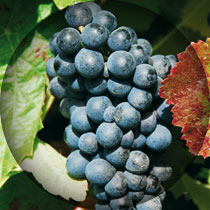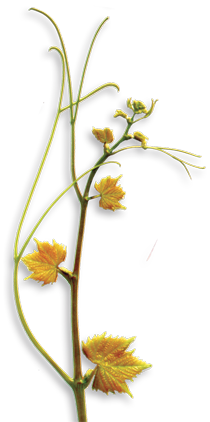Espadeiro (PT)
Variety: red | Category III | Portugal


General Information
Espadeiro


Origin: This variety has its origins in the North-Wast of Portugal. It was described by Fonseca (1790: 35) and Lobo (1790: 73). Vila Maior (1875) mentioned it together with three homonymous varieties. Ferreira Lapa (1874) knew of this variety as a homonym of the Trincadeira variety in the Azeitão region.
Chief areas of distribution: Minho.
Official synonym(s) (national and OIV): None.
Historic and regional synonyms: Padeiro, Tinta dos Pobres.
Homonym(s): In Azeitão, Trincadeira. There is a white variety and previously (Meneses, 1896) there were 14 varieties with this name.
Area under cultivation: 1,600 ha.
New plantings: Less than 0.25%.
Trend: Insignificant.
Varietal variability: Medium.
Availability of propagating material: RNSV polyclonal material available.
Molecular Profile (OIV)
Regional Classification
Morphology
Phenology
Vegetative Potential
Viticultural Parameters
Oenology
Variety Characteristics
| VVMD5 | VVMD7 | VVMD27 | VrZag62 | VrZag79 | VVS2 | ||||||
| Allele1 | Allele2 | Allele1 | Allele2 | Allele1 | Allele2 | Allele1 | Allele2 | Allele1 | Allele2 | Allele1 | Allele2 |
| 222 | 226 | 243 | 259 | 183 | 189 | 196 | 204 | 251 | 251 | 135 | 153 |
DOC quality wine: Vinho Verde, in the sub-regions of Amarante, Ave, Basto, Cávado, Lima, and Sousa.
Regional wine: Minho.
Young shoot (form of tip): Open with crimson red tip, sparse erect hairs.
Young leaf: Green with yellow tinges. Sparse erect hairs on lower side of blade.
Young shoot: Green with red stripes, green nodes.
Mature leaf: Of medium size, pentagonal, three lobed, dark green blade, irregular, slight blistering. Glabrous on lower side of blade. Convex teeth of medium size. Slightly open V-shaped petiolar sinus.
Bunch: Large, conical, medium density, medium peduncle.
Berry: Medium size, round, blue-black, skin of medium thickness, easy to detach. Flesh firm.
Woody shoot: Yellowy brown.
Time of bud burst: Late, 10 days after the Castelão.
Flowering: Normal, 6 days after the Castelão.
Berry (colour change): Late, 10 days after the Castelão.
Berry (harvest ripe): Late, one week after the Castelão.
Vigour of shoot growth: Very high.
Pruning weight:: High.
Shoot attitude (habit): Erect, plagiotropic.
Length of internodes: Medium. Its prominent internodes in winter make this variety easy to recognise.
Shoot length: Medium to sometimes very long.
Tendency to form lateral shoots: Low.
Rate of multiple bud bursts: Medium.
Bud fertility index: Medium, approximately 1.4 flowers per shoot.
Yield: Medium to high, depending on bunch density (8,000 – 16,000 kg/ha). RNSV statistical value: 8.04 kg/vine (average of 40 clones in Lousada over 4 years).
Yield consistency: Inconsistent.
Crop uniformity: Uniform.
Winkler Index: 1338 (Arcos de Valdevez).
Sensitivity to abiotic factors: Not known.
Susceptibility to fungal diseases: Medium susceptibility to most common fungal diseases.
Susceptibility to Pests: Not known.
Bunch size: Very large.
Seeds per berry: 2.2.
Vineyard conduction system: Traditionally, vines grew on trees. Nowadays, the cordon training system is used.
Soil requirement: Humid, weathered granite soils.
Climatic requirements: Tolerates wind and rain.
Vine density: Variable, mostly 1,200 – 2,000 vines/ha.
Rootstock: No known incompatibility.
Incidence of coulure/millerandage: Not susceptible.
Spoilage of mature berries: Minimal.
Risk of bird damage: Very low.
Machine harvest suitability: Suitable, although usage not widespread.
Hand harvest suitability: Suitable.
Wine type: Quality light red or rosé wine.
Potential alcohol content: 9% - 12% vol.
Natural acidity of must: High 6-9 g/l
Colour intensity of wine: Low.
Tannins: Monomeric 55.9 mg/l; oligomeric 262 mg/l; polymeric 4667 mg/l.
Risk of oxidation of wine: Low.
Aromatic profile: Not analysed.
Ageing Potential: High.
Blending recommendation: Vinhão (because of its colour intensity).
Wine Descriptors: the wines produced from must low in alcohol are often bright red to ruby red, with an acidic taste and aroma typical of the variety (EVAC 2002).
Wine quality: High, and typical of the region.
Variety Characteristics: Vinho Verde type wine of high colour intensity, because of the bica aberta must fermentation method used.

